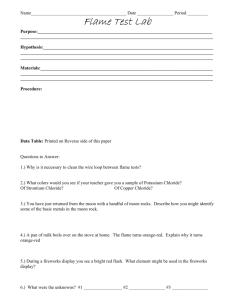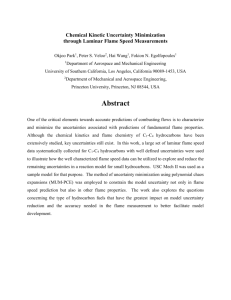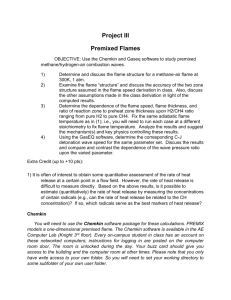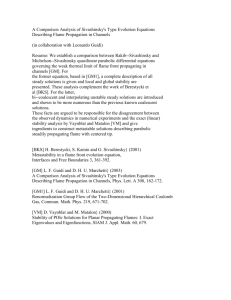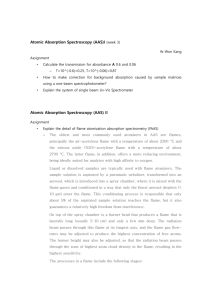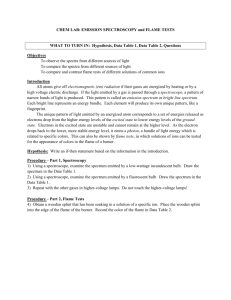Manual for flame atomic absorption spectroscopy
advertisement
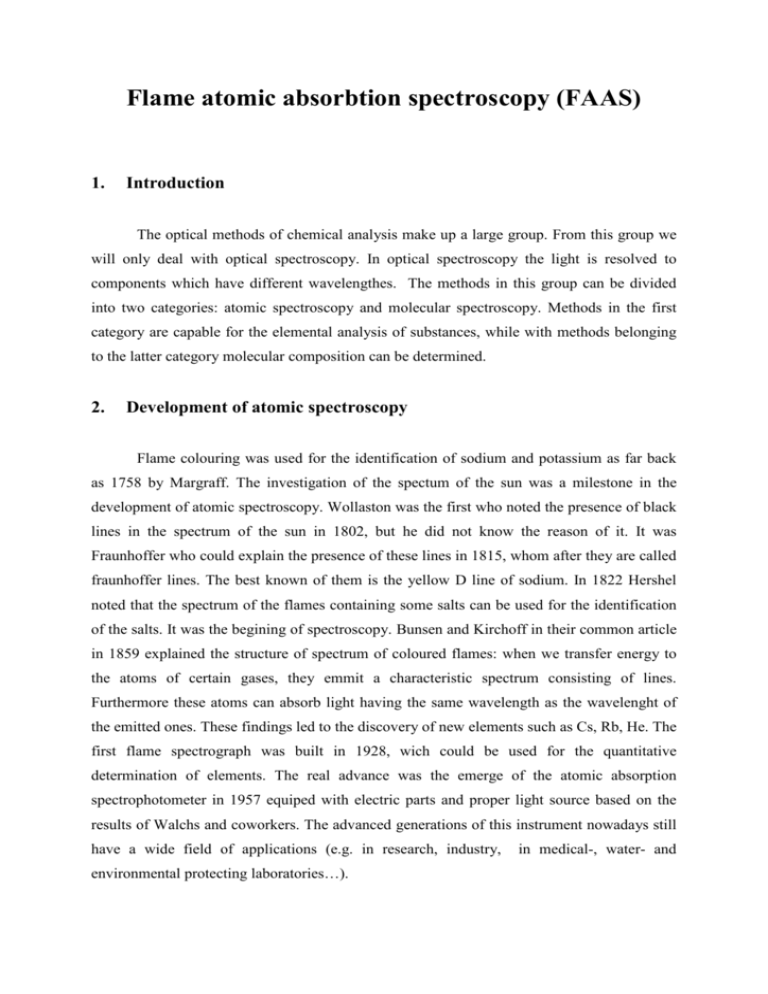
Flame atomic absorbtion spectroscopy (FAAS) 1. Introduction The optical methods of chemical analysis make up a large group. From this group we will only deal with optical spectroscopy. In optical spectroscopy the light is resolved to components which have different wavelengthes. The methods in this group can be divided into two categories: atomic spectroscopy and molecular spectroscopy. Methods in the first category are capable for the elemental analysis of substances, while with methods belonging to the latter category molecular composition can be determined. 2. Development of atomic spectroscopy Flame colouring was used for the identification of sodium and potassium as far back as 1758 by Margraff. The investigation of the spectum of the sun was a milestone in the development of atomic spectroscopy. Wollaston was the first who noted the presence of black lines in the spectrum of the sun in 1802, but he did not know the reason of it. It was Fraunhoffer who could explain the presence of these lines in 1815, whom after they are called fraunhoffer lines. The best known of them is the yellow D line of sodium. In 1822 Hershel noted that the spectrum of the flames containing some salts can be used for the identification of the salts. It was the begining of spectroscopy. Bunsen and Kirchoff in their common article in 1859 explained the structure of spectrum of coloured flames: when we transfer energy to the atoms of certain gases, they emmit a characteristic spectrum consisting of lines. Furthermore these atoms can absorb light having the same wavelength as the wavelenght of the emitted ones. These findings led to the discovery of new elements such as Cs, Rb, He. The first flame spectrograph was built in 1928, wich could be used for the quantitative determination of elements. The real advance was the emerge of the atomic absorption spectrophotometer in 1957 equiped with electric parts and proper light source based on the results of Walchs and coworkers. The advanced generations of this instrument nowadays still have a wide field of applications (e.g. in research, industry, environmental protecting laboratories…). in medical-, water- and Flame spectrometry includes three methods: a) Flame emission spectroscopy (FES): We measure the intensity of molecular bands or atomic or ionic lines emitted by excited molecules, excited atoms or even by excited ions. b) Flame atomic absorption spectroscopy (FAAS): We let through the fire a light beam with such a wavelenght that can be absorbed by ground state atoms and thus we measure the decrease of light intensity. b) Atomic fluorescent spectroscopy We irradiate the ground state atoms with an external light source, however we measure the intensity of emitted light at the characteristic wavelenght instead of the decrease of light intensity due to the absorbtion of light The greatest importance is credited to FAAS. FES can be applied at a much smaller application field. Although AFS is rather sensitive, the potential of the method compared to FAAS only for a few elements is comperable, thus it is relatively less popular. Recently flameless atomization (graphite furnace atomic spectroscopy, GFAAS) keeps getting more and more significant since it has small sample volume demand, high sensitivity and good detection limits. 3. Construction of flame spectrometers Most parts of flame spectroneters are very similar or the same, thus the commercial flame atomic absorption spectrometers can be used as flame emission spectrometers as well (Fig 1). In case of FES the examinated particles (excited atoms) are produced by the flame itself. For FAAS and AFS measurements to excite ground state atoms external lightsource is needed. In FAAS the light of the light source (to be more precise that part of the light which is not absorbed) gets directly to the light resolving unit, the monochromator (the light source, the flame and the monochromator are arranged in such a way that they are in one line). Although in AFS the light of the light source can not get to the monochromator thus we measure only the intensity of secondarly emitted light. In newer instruments the light resolving unit (monochromator) is the diffraction grid, the detection of the light is attributed to the photomultiplier. The signal processing/displaying unit of the pfotometers can be very different (analog/digital displays, graphical recorders), but the modern spectrometers are equipped with computers. Figure 1. Principles of instruments used for atomspectrometric methods 3.1 Sample introduction The aim of sample introduction is to introduce samples (mostly liquids) to the flame with good reproducibility and with high efficiency so that the interfering effects should remain minimal (the liquid must be introduced as fine aerosol). The sample introduction is most often spraying the liquid. The small droplets formed in the nebulization transform gradually while going through the high temperature zones of the flame. It is an important aspect that the particle size of the droplets (<5µm) should be possibly in similar size ranges in order the particles to be desolvated and to be further transformed in the same region of the flame. For the nebulization of solutions the indirect pneumatic nebulization is the most frequently used method which has a sample introduction efficiency about 10%. In Fig. 2. the structure of a typical pneumatic system used for premixed flames can be found. The sample gets into the nebulizer through a plastic capillary. In the nebuliser shown in Fig. 3 the sample leaving the capillary is surrounded by the gas (air) feeding the flame. After this high speed gas comes out through the tight emergent hole of the nozzle pressure decrease is established in the capillary wich results the take up of the liquid. By the way the high speed gas breaks the uptaken liquid into small drops thus aerosol is formed. The latter phenomenon is called Venturi effect (Fig. 4.) Figure 2. Structure of concentric pneumatic nebulization system Figure 3. Venturi effect The position of the nebuliser’s capillary can be adjusted by a srew and by this way the sample take up speed and the aerosol size dsitribution can be optimized. The size distribution of the formed primer aerosol is further refind by a glass impact bead placed in front of the nebuliser (secunder aerosol is formed). The larger drops of the aerosol hit the impact bead, however, the smaller ones can go rond of it whithout precipitating. Figure 4. Role of impact bead in the development of secundary aerosol 3.2 Types of burners and flames In the first spectrometers Meker burners were used. These burners are actually such tubes that are coverd from one end with a plate containing several holes. The application of this burner is appropriate for flames with slow burning speed. Nowadays burners with slots are the most frequently used burner types. The 10 cm long slot is favourable especially for the absorption measurements in air/acethylene flame. In the design of sloted burners the width and the length of the slot, and the heat conducting property of the material of the burner is of great importance. The temperature of the most commonly used burners is in the range of 2200-3300 °C (table 1.). In this temperature range only the spectrum lines having higher excitation energy than 4.5 eV can be excited. The emmitted light of the flame is sophisticated. In case of the most commonly used air/acethylene flame the emission spectrum consists of the followings: a) from the background radiation of flame (excited radicals of solvent and flame gases) b) from molecular bands and spectral lines of excited atoms in the flame Table 1. Gas mixture composition Hydrocarbon (methane, propane-buthane) – air Acethylene - air Hydrogene - oxygene Acethylene - dinitrogene-oxyde Dicyanide - oxygene Carbon subnitride – ozone °C 1900 2300 2700 3000 4500 5300 The flames can be categorized from several points of view. One is based on the mixing way of the combustible gases and the combustion feeding gases. When the gases are mixed before the combustion as in the case of Bunsen burner (Fig. 5.), we can speak about premixed flame. When the oxygene feeding the combustion gets to the flame from air, the flame is called diffusion flame as in the case of the flame of a candle. Figure 5. Shematics of Bunsen flame 1 open end of the burner; 2 prewarming zone; 3 reaction zone; 4 inner combustion zone; 5 outer combustion zone; ν is the flow rate of the gas mixture; uf is the rate of combustion of the flame We make difference between the flames on the basis of the flow rate of the components and the rate of the burning, thus flames that have smaller Reynolds number (Re) than 2300 are called laminar flames. In case of higher Reynolds number that is at higher combustion rate the flame is turbulent. Stationar, standing flame is established when the flow rate of the flame (v) is the same as the rate of burning in the opposite direction (uf). When v>Uf the flame is blown off, and when v<Uf, the flame „burns back” 3.3 Processes occuring in flame From the liquid drop the solvent evaporates first, and solid aerosol particles (microsized crystals of salts) are formed, in the next step it looses its’crystalline water (if possesed) then the crystals melt and evaporate that is molecule vapour forms. In the higher regions of the flame the thermal dissociation of the molecules occurs: ground state atoms are formed (for atomic absorption measurements only these particles are useful). Of course, when the temperature of the flame makes it possible, the thermal prcesses go further, by the side of the ground state atoms excited atoms, even ions will be present in the flame (these excited particles are useful only for emission measurements). Figure 6. Processes occuring in flame 3.4 The resolution of light The light leaving the flame is led to the detecting unit with a proper optical device. Due to the background radiation of the flame and the emission of the other metals present in the flame with direct measurements we can not get proper results. By the help of an optical device we try to eliminate the interfering radiations and we let only the almost monocromatic, to the investigated metal characteristic light to the detector. While formerly this function was tried to be fulfiled with colour filters, nowadays nearly there are only monochromators in use. The monochromators are capable for the separation of small wavelenght ranges with 0,01-1 nm width in a wide (190-800 nm) spectrum. The two major type of monochromators are prisms and optical (diffraction) grids. The desired wavelength is set by rotating the prism or diffraction grid. Although by increasing the size of the slit, the intensity of the light increases, however, the purity of the spectrum decreases. The material of the prism in UV range is quartz while in UV visible range glass. The adventage of the prism type monochromators is that they provide a spectrum with high light intensity although it has a disadventage too: the resolution is low The diffraction grid is such a glass, quartz or specular metal surface, on wich there are paralell sratches near to each other at a same distance (1000-4800 cratch/mm). The intermediate space between the sratches are transparent to light while the scratches themselfes do not let the light through. Owing to the high number of sratches the deflection iterference pattern we get contains sharp maximums (Huygens principle). A grid irradiated with white (that is blended) light diffracts the different wavelenght (that is different coloured) light beams in different direction, thus it acts like a prism. Thus the grid splits up white light into homogeneous colours. In Fig. 7. the light pathway of some component of dispersion and difraction spectrum can be seen produced by prism and diffraction grid. Table 2. shows the wavelenghtes related to different colours. Figure 7. Light pathway of some components of dispersion and diffraction spectrum produced by prism and diffraction grid Table 2. Wavelengthes related todifferent colours Shade of colour Red Reddish orange Wavelenght (nm) 721 656 Orange Yellow Green Bluish green Blue Violet 600 589 495 490 410 396 3.5 Detectors The light intensity passed through the detector can be measured with different measuring devices. In the begining of flame photometry photographic light measurements were used, but nowadays instead of them solely photocells or photomultipliers are in use. The multipliing factor of photomultipliers might be as well 1010. The principle of photomultipliers (Fig. 8) is the following: Photons impacted to K photosensitive cathode produce electrons which flow towards the P1 dinode due to the potential between P1 dinode and K cathode. Electrons impacting to P1 dinode creates a secunder electron emission of wich intensity is larger then the primer electron current. This process is repeted on the following (P2-P11) dinodes until the anode. The number of electrons increases exponentially with the number of dinodes. Figure 8. Shematics of photomultiplier 4. Flame emission spectrometry (FES) Flame emission spectrometry is the quantitative application of the well known flame colouring probes. As we mentioned it earlier, even the alchemists knew that some materials change the colour of a colourless (spirits of wine) flame. The atoms of some elements in form of volatile compounds are excited, ionized even in the few hundred °C temperature gas flame. The absorbed thermal energy is emitted in form of light with characteristic wavelenght (characteristic colour). Ecspecially the alkali metals and alkaline earth metals have this property, the atoms of other elements get atomized at more higher temperature- even at severel thousand degrees. When we moisten a solid substance with hidrochloric acid and carry it on an O-shape ended platinum wire and put it into a colourless flame, we can observe a flashing light. We can make our measurement more precise when we detect the colured light instead of with our eyes with a simple spectroscope. In this case the wavelenght of the coloureful lines appearing in the visible spectrum (400-800 nm) can be determined as well. The theoretical bases of flame emission mesurements is that when an atom absorbs an energy quantum it is converted to excited state. When the excited atoms return to ground state, photon is emitted. For example when we heat a piece of glass in a flame, the obsered yellow colour of the flame is credited to the presence of sodium atoms in the glass. The frequency or the wavelenght of the emitted light can be calculated from the energy of the light: where h is the Planc constant (6,62·10-34 Js), ν is the frequency of the light, λ is the wavelenght, c is the speed of light in vacuum (≈ 3·108 s) The excititaion energy and the wavelenght of the emitted light is characteristic to the atom. The number of atoms in excited state growths exponentially with the temperature. The atoms stay in excited state for about 10-8 sec than the atom emits a photon spontaneously. In flame emission spectrometry the sample is introduced to the flame and the intensity of the emitted light is measured. We measure the light intensities in case of known concentration samples and with the help of this calibration curve we can determine the concentration of unknown samples. Flame emission spectrometry is a rapid and cheap method which can be used for the analysis of readily excitable alkali and alkaline earth metals. The other elements can not be excited due to the relatively low temperature of flame. Nowadays this method is used mostly in medical diagnostics for the determination of sodium and potassium level in blood and other bodily fliud. The application field can be significantly expanded by using higher temerature flame (dinitrogene-oxide/acethylene flame). 5. Flame atomic absorption spectrometry Flame atomic absorption spectrometry is a quantitative analytical method based on measuring the light absorption of free, ground state atoms. The ground state atoms are excited by electromagnetic radiation (light), while absorbing photons having equivalent wavelenght with the excitation energy. The absorption spectrum of atoms (similarly to emission spectrum) is line spectrum. The lines are present at exactly determined wavelengthes and they have a very small, approximately 0,001 nm FWHM (full widht at half maximum). This type of absorption spectrum of atoms gives the high selectivity of atomic absorption spectrometry. At the best line of a given element the probability of absorption of other elements is very low thus complex systems containing several elements can be analyzed without the separation of elements. This procedure has great adventage to molecule absorption spectrometry methods where there is a higher probabilty of optical interfering effect due to the band absorption and usually the analysis of complex systems is possible only after the application of separation techniques. With atomic absorption we measure the concentration of free atoms in the atomizing unit. The relationship between the decrease of light intensity at the wavelenght of the examined metal and the concentration of free atoms in a unit of volume is described by Lambert-Beer law as follows: where A=absorbance I0 = initial light intensity before absorption I = Light intensity after absorption a = absorption coefficient (constant depending on material properties) c = number of free ground state atoms in the atomizing unit (flame) l = lenght of way passing the light in the atomizing unit Thus the absorbance is directly proportional to the number of free, ground state atoms in a unit of volume. Furthermore the number of free atoms in the flame is proportional to the concentration of analyte in the solution. When the concentration is doubled, the number of ground state atoms in the atomization unit is doubled as well. (Of course only when the parameters of analysis of sample and calibrating solutions are the same.) In order to perform atomic absorption measurements the light of the light source producing characteristic, sharp spectrum of the element to be measured should be led through the flame where the aerosol is present in form of fine spray. The narrow range of the spectrum containing the resonance line of the element is separated from the other part of spectrum with a monochromator. The selected resonance line gets to the light sensoring detector (like photomultiplier), of which signal is amplified. To exclude the emitted light of the flame, the light of the light source is chopped with a chopper and in the detector it gives alternating current, while the background radiation of the flame gives direct current. Based on the implementation of it, there are single beam (Fig. 9. a and b.) and double beam photometers (Fig. 9. c.). Figure 9. Arrangement of single beam (a, b) and double beam (c) atomic absorption spectropfotometers (1 light source; 2 flame; 3 monochromator; 4 detector; signal processing and displaying unit) For atomic absorption measurements light sources providing intensive line spectrum are needed and the FWHM of the emitted lines should be small. The hollow cathode lamp (HCL) is such a light source wich is a special discharge tube (Fig. 10). The cathode is made from the material of the examined element and it has a cylindrical shape. The discharge is established due to the 300- 400 V potential put between the cathode and anode resulting the electron emission of the cathode. Accelerating the electrons in the electric field gives rise to the avalanche-like ionization of the filling gas of the HCL. Noble gas ions travelling at high speed impact to the cathode and metal atoms are torn out from the surface of the cathode (cathode atomization). The free atoms of the examined elements are produced by this way. These atoms collide with the noble gas ions travelling at high speed and a line spectrum characteristic to the desired element is emitted. HCLs are usually monoelementals thus lamps are need to be changed when turning to the measurement of a new elemet. Figure 10. Parts of hollow cathode lamp Each elements those have resonance line in that range of the spectrum which can be measured by the detector can be determined with AAS. Most of the instruments can be used in UV and visible range (190-800 nm). Noble gases, halogenes and C, H, S, O, N, P cannot be determined since the resonance line of these elements are under 190 nm. The elements of which oxides do not decomposes in flame or which produce oxides or hidroxides in flame can be determined difficultly. 6. Evaluation methods In flame spectrometry comprehensive calibration and standard addition calibration are the two most often used evaluaton techniques. Comprehensive technique can be applied in case of big number samples of the same type. The comprehensive solution series (standards) contain increasing quantity of the examined elements. Moreover the standards may contain other components present in the samples (cations, anions, organic compounds, solvents) in average concentration. Since the composition of validation series made by this way is about the same with sample composition, the arrising interfering effects will be about the same. The parts of the calibration series are usually diluted from a stock solution with exactly known concentration. This methode provides analitically reliable results only in case of samples belonging to the same type with relatively steady composition. We would determine for example calcium with large error if we used the same composition calcium standard for the analysis of blood serum, water sample and ore solution made from rock pieces. In the mentioned samples not only the concentration of components present besides calcium differ significantly but also the type of arising interfering effects may be different. A typical calibration diagram from comprehensive evaluation method is seen in Fig. 11. Figure 11. Comparison evaluation method Standard addition method is applied primerily in case of so called exponential interfering effects, when we do not know the cause of interfering effect or we do not know the quality and concentration of interfering components respectively. The point of the method is that the samples are divided into 3-5 equal parts. We give to each portion increasing amount of examined metal ion in the same volume. To the first portion we do not add any metal ion solution thus it contains the examined metal ion in the original concentration (this unkown is the „+0” member in addition series.), to the other members known increasing amount of examined metal solution is given. The results should be ploted like in Fig. 12. The linear line fit to measure points (intensity of emission or absorbance) intersects the abscissa axis beyond 0 in negative range. The scale is the same than in positive range. The absolute value of the distance between the intersect and the origo gives the metal ion concentration of the sample. The condition of the aplicability of the method is that a linear line should be able to fit on measure points. To perform standard addittion on severeal samples however makes it much work demanding thus it is not capable for serial analysis. It makes hard to use this method when the volume of sample solution is limited (1-2 mL). In case of complex samples containing mostly organic substance matrixes, standard addition method is often used. Figure 12. Standard addition method 7. General orders to perform the exrecises, to evaluate the results 1. Dilute the solutions with 0,1 M concentration nitric acid. The same acid solution is the so called blank. For the determination of limit of detection measure the absorption signal of blank solution. Write down 5-7 subsequent signals. 2. To prepare standard solutions use the so called dilution equation: C1·V1 = C2·V2, where C1 is the concentration of the stock solution, V1 is the volume of the stock solution needed, C2 is the concentration of the desired standard solution, V2 is the volume of the desired standard solution. 3. Skake the solutions extensively after prepared and keep the volumetric flask sealed. Shake it again before introducing to the instrument. 4. The order of analysis: first the blank, then the standard solutions in increasing concentration, and the samples follow (possibly the most diluted ones first). 5. Calculate the analytical sensitivity, limit of detection and the standard deviation for a chosen standard solution! 8. Tasks to be completed in the exercise 1. Determination of Copper ion in Béres®csepp samples with standard addition calibration method Description As sample preparation you have to prepare 4 solutions, each of them containing Béres®csepp in a 100 time dilution, and different ammounts of additional copper. The first one is the zero member of the calibration series which contains only the 100 time diluted Béres®csepp. The second one is the +1 member, which contains the 100 time diluted Béres®csepp and 1 mg/L additional copper ion. The next one is the +2 member, wich contains beside the Béres®csepp 2 mg/L addditional copper. The last one is the +3 member, which contains the 100 time diluted Béres®csepp and 3 mg/L additional copper. For the preparation of the solutions 25 mg/L copper standard stock solution and 25 ml volumetric flasks are available. After you pipette the Béres®csepp and the copper to the flasks, you have to fill it up to mark whith 0,1M nitric acid, and detrmine the absorbance of the samples for copper, draw the curve of standard addition calibration and determine the cupper contant of 1 drop (55ηL) Béres®csepp. 2. Determination of Copper ion in Béres®csepp samples with comperative calibration method Description As calibrating solutions you have to prepare 5 solutions wich contain 1, 2, 3, 4, 5 mg/L copper respectively. As a sample you have to prepare a 50X and 100X fold dilution from the Béres®csepp . For these purposes 25 mg/L copper standard stock solution and 25 ml volumetric flasks are available. After you pipette the Béres®csepp and the copper to the flasks, you have to fill it up to mark whith 0,1M nitric acid, and determine the absorbance of the samples for copper, draw the curve of comperative addition calibration and determine the copper contant of the Béres®csepp. 3. Determination of Na ion concentration from tapwater with comprehensive calibration methode Description Standard solutions: Prepare 1, 2, 3, 4, 5 mg/L standard solution in 25 mL volumetric flasks from the available 25 mg/L standard stock solution . Sample: Let water flow from the tap for 0,5-1 minute then collect approximatelly 20 mL in a smaller beaker. Prepare a 10 and 20 fold dilution from the collected tapwater in 25 mL volumetric flasks, however keep the remained original sample (undiluted sample). Task: Determine the concentration of Na+ of tapwater. Give the result in mg/L unit. 9. Guidline for the preparation of labmanuals Title of the practice (Name, major, date) Theoretical summary After reading carefully the suppliing material, write the most important concepts and facts about in one page extent. Try to prepare readable handwriting texts, the different parts of the labmanual should be clearly arranged Tasks to be completed Task: List the tasks you have to complete. Copy the description to your lab manual Measument parameters: Give every important measuring parameters. In FAAS these are the followings: Type of the instrument (Unicam SP1900) Flame (e.g. air/acethylene stoichiometric flame) Burner: (FES: Meker type, FAAS: 10 cm sloted burner) Wavelenght (e.g. in case of Cu: 324.8 nm) Observation height (e.g. 10 mm) Available tools, standards, samles, sample preparation The list of used volumetric flasks, pipettes, standards. You have to write down the way of calculation of sample preparation. Experimental results Use charts and pay attention to the unit of measurements Sample(blank, Std., unknwn) 1 2 Signal (relative absorbance/intensity) 3 4 5 Average Av.-blnk Evaluation of the results The calibration curve can be prepared on a mm scale paper or in Excel or in other spreadsheet softwares. Give titles for the diagrams and show the labels of axises. (e. g. copper concentration, mg/L). For each methods the following analytical properties should be calculated: analytical sensitivity, limit of detection and standard deviance for one chosen sample. Analytical sensitivity (S): Where x: the signal of solution c: concentration of solution Standard deviation (s): Where ¯ x is the averege of xi….xn signals from a solution of c concentration after n replications Limit of detection (D): D = 3s/S Discussion, observations, explanations Write down the most important observations, interpret the results (are they real?) Write down the extraordinary findings if happened (e.g. problems with instrument, problems with sample preparation) and try to find explanations to them. 10. Possible questions for the short test 1. Principle of flame spectrometric methods (emission, absorption, fluorscence). 2. What kind of processes occur when a metal salt is introduced to flame? What kind of particles are used for flame absorption spectrometry and for flame emission spectrometry? 3. What are the main parts of FES instruments? What is the function of the units? 4. What are the main parts of FAAS instruments? What is the function of the units? 5. Give a general description about the most commonly used flames in flame spectromettry 6. What is the way of sample introduction to the spectrometers? 7. Give the main parts of hollow cathode lamp, the principle of functioning of hollow cathode lamp. 8. What is the way of the resolution of light? How do the light resolving units work? 9. What is the way of the detection of light in spectrometers? 10. Describe the two most commonly used evaluation methods (comprehensive calibration, standard addition calibration)



